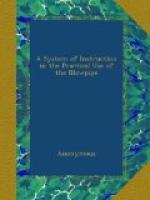(4) in forceps. I. In reducing flame is magnetic.
(5) in borax. Gives the iron reaction.
(6) in mic. salt. Gives the iron and silica reactions.
(7) with carb. soda. Fuses to a black opaque bead.
(8) Special reactions. Generally
gives the manganese reaction with
nitre
and carbonate of soda.
* * * * *
Mineral. Chloropal
Formula. [...Fe=][...Si]^{2} + 3[.H].
Behavior
(1) in glass-bulb. Decrepitates
more or less, gives off much water
and
turns black.
(2) in open tube. —
(3) on charcoal. —
(4) in forceps. V. Loses color and turns black.
(5) in borax. Gives the iron reaction.
(6) in mic. salt. Gives the iron and silica reaction.
(7) with carb. soda. Fuses to a transparent green glass.
(8) Special reactions. —
* * * * *
Mineral. Green earth
Formula. [...Si],[.Fe],[...Al=],[.Na],[.K],[.H], etc.
Behavior
(1) in glass-bulb. Gives off water and becomes darker in color.
(2) in open tube. —
(3) on charcoal. —
(4) in forceps. V. In reducing
flame fuses on edges and colors
the
outer flame yellow ([.Na]) or violet ([.K]).
(5) in borax. As the preceding.
(6) in mic. salt. As the preceding.
(7) with carb. soda. Forms a slaggy mass.
(8) Special reactions. —
* * * * *
Mineral. Siderite
Formula. [.Fe][..C].
Behavior
(1) in glass-bulb. Occasionally
decrepitates. Gives off CO^{2} and
turns
black and magnetic.
(2) in open tube. —
(3) on charcoal. As in glass bulb.
(4) in forceps. Behaves similarly to the magnetic oxide.
(5) in borax. Gives the iron and manganese reaction.
(6) in mic. salt. As in borax.
(7) with carb. soda. Behaves as
an oxide. With nitre and carbonate of
soda
on platinum generally gives the manganese
reaction.
(8) Special reactions. In acid dissolves with effervescense.
* * * * *
Mineral. Copperas
Formula. [.Fe][...S] + 7[.H].
Behavior
(1) in glass-bulb. Gives off
water, and, when strongly heated,
SO^{2}
and SO^{3}, which reddens litmus paper.




